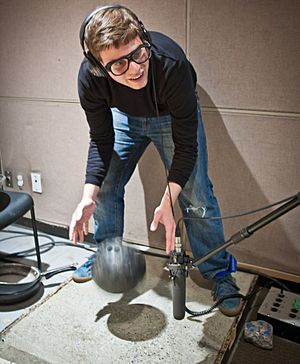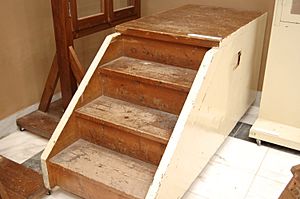Foley (filmmaking) facts for kids
In filmmaking, Foley is a cool way to add everyday sounds to movies, TV shows, and other media. These sounds are made *after* the main filming is done, during a stage called post-production. They help make the movie's audio sound much better. These special sounds are named after a sound effects artist named Jack Foley.
Foley sounds can be anything from the rustle of clothes and footsteps to squeaky doors and breaking glass. They make the movie feel more real and exciting to watch. Foley can also hide unwanted noises that were accidentally recorded during filming, like airplanes flying overhead or cars passing by.
Foley artists work in special rooms called Foley stages or studios. They recreate sounds that match what's happening on screen. Sometimes, the things used on a movie set don't sound real. For example, a fake wall might not sound like a real brick wall when someone touches it. That's where Foley comes in! The best Foley sounds are so good, you don't even notice them. They just make the scene feel right. Without these important background noises, movies would feel strangely quiet and a bit uncomfortable.
Contents
The History of Foley Sounds
The idea of adding sounds to stories started way back in the 1920s with live radio shows. Back then, recordings weren't very good. So, a sound effects person had to create all the sounds live as the radio play was happening.
Jack Donovan Foley began working with Universal Studios in 1914, when movies were still silent. When the first movie with sound, The Jazz Singer, came out, Universal knew they needed to catch up. They asked employees with radio experience to help. Jack Foley joined the sound team. They helped turn Universal's silent musical Show Boat into a musical with sound.
In those early days, microphones could only pick up voices. Other sounds had to be added later. Foley and his small team would watch the movie on a screen. At the same time, they would record their live sound effects onto a single audio track. Their timing had to be perfect! Footsteps and closing doors had to match exactly what the actors were doing on screen. Jack Foley continued making sounds for films until he passed away in 1967. His basic methods are still used today, though technology has made things easier.
Modern Foley art has changed a lot as recording technology improved. Today, sounds don't have to be recorded live all at once. They can be recorded separately on different tracks. Then, they are carefully matched up with the video. Foley studios now use hundreds of props and digital effects to create all the sounds for movies.
Why Foley is Used in Movies
Foley sounds either add to or completely replace sounds recorded during filming. Most movies use a mix of both. A Foley artist is the person who creates these sounds. They use their creativity to make viewers believe the sound effects are real. You shouldn't even realize the sound wasn't part of the original filming!
Foley sounds are added to a film *after* it has been shot, during post-production. This is often needed because the original sounds captured during filming might have unwanted noise. Or, they might not sound strong enough to match what's happening on screen. For example, fight scenes in an action movie are usually staged. So, they don't have the real sounds of punches landing. Also, props and costumes on set are often made of cheap materials. They might look real but don't sound like the real thing. Explosions and crashes are also often added or made bigger in post-production.
By adding these sounds later, editors have full control. They can decide how each noise sounds, its quality, and how loud it is. Foley effects add depth and realism to the sound of movies and other media.
Foley artists watch the film to figure out what sounds they need. Once they gather their materials, they practice making the sounds. When they get the sound just right, they watch the film again and add the sound effects at the same time. This is a bit like how actors re-record their dialogue, matching their voices to the video.
Sometimes, dialogue is replaced using a process called dubbing. When this happens, any sound effects recorded with the original dialogue are lost. This is another reason why Foley is so important. When movies are translated into other languages, all the original sounds might be replaced. Foley artists then add back all the important background noises.
How Foley Sounds Are Made
Foley sounds are created by the artist mimicking the actual sound source in a recording studio. There are often many small sound effects in any movie scene. Recording all of them can take a lot of time.
Foley art can be divided into three main types: feet, moves, and specifics.
Feet Sounds
This type of Foley is all about footsteps. To make the sound of someone walking down stairs, Foley artists might stomp their feet on a marble slab while watching the movie. Foley studios have many different types of shoes and floors to create footstep sounds. These floors, called Foley Pits, can be anything from marble squares to gravel and rock pits. Making the perfect footstep sound can really improve how a scene feels. Foley artists who work on footsteps are sometimes called "Foley Walkers" or "Steppers."
Movement Sounds
The "moves" category includes many of the quieter sounds you hear in films. For example, the swishing sound of clothing when two actors walk past each other. This sound is made by rubbing two pieces of the same material together near a microphone. The artist matches the rubbing speed to how the actor's legs cross. Sometimes, cloth isn't even used. The final decision is up to the sound mixer who controls the movie's audio.
Specific Sounds
Foley can also include other sounds, like doors closing or doorbells ringing. However, these are often done more easily using pre-recorded sound effects, which are put in place by sound editors.
Foley effects also help the viewer understand the size of a space. For example, a large hall will have a strong echo. A small room might only have a slight echo. Open outdoor spaces usually have no echo at all.
Clever Foley Tricks
Foley artists use many clever tricks to make sounds:
- Corn starch in a leather pouch can sound like snow crunching.
- A pair of gloves can sound like bird wings flapping.
- An arrow or thin stick can make a whoosh sound.
- An old chair can make a controlled creaking sound.
- A water-soaked rusty hinge placed against different surfaces makes a creaking sound. Different surfaces change the sound a lot.
- A heavy staple gun combined with other small metal sounds can make good gun noises.
- A metal rake can make the rattling or squeaking sound of a chain-link fence. It can also make a metallic screech when dragged across metal.
- A heavy car door and fender can create most car sounds. But having a whole car in the studio is even better!
- Burning plastic garbage bags cut into strips can make a realistic candle or soft fire sound as the bag melts.
- Quarter-inch audio tape balled up sounds like grass or brush when walked upon.
- Gelatin and hand soap can make squishing noises.
- Frozen romaine lettuce can make bone or head injury noises.
- Coconut shells cut in half and stuffed with padding make horse hoof noises.
- Cellophane creates crackling fire effects.
- A selection of wooden and metal doors is needed for all sorts of door noises. They can also be used for creaking boat sounds.
- Acorns, small apples, and walnuts on a wooden floor can be used for bones breaking.
- Walnuts are used instead of ice cubes in a glass of water because they don't melt.
- Canned dog food can be used for alien pod expulsions and monster noises.
- Large, thin metal plates, when bent, can be used for thunder.
In the movie Star Wars, sound designer Ben Burtt created many unique effects. The light saber buzz was a mix of a film projector motor and a television picture tube hum. Blasters were based on the sound of taut radio tower wires being struck. Darth Vader's breathing came from a diving regulator. The TIE fighter swoosh is a mix of slowed-down elephant noises and cars driving through water. Chewbacca's voice includes the moaning of a walrus. R2D2's beeping talk includes Burtt's own voice mixed with synthesized sounds to make it sound more human.
See also
 In Spanish: Efecto de sala para niños
In Spanish: Efecto de sala para niños
- Sound design
- Berberian Sound Studio, a film about Foley work
- Lisbon Story, which also shows some Foley scenes




